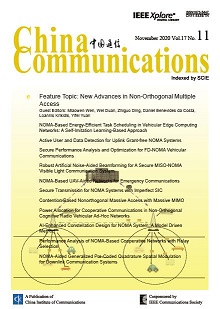Donghong Cai, Jinming Wen, Pingzhi Fan, Yanqing Xu, Lisu Yu
2020, 17(11): 12-28.
This paper proposes some low complexity algorithms for active user detection(AUD), channel estimation(CE)and multi-user detection(MUD)in uplink non-orthogonal multiple access(NOMA)systems, including single-carrier and multi-carrier cases. In particular, we first propose a novel algorithm to estimate the active users and the channels for single-carrier based on complex alternating direction method of multipliers(ADMM), where fast decaying feature of non-zero components in sparse signal is considered. More importantly, the reliable estimated information is used for AUD, and the unreliable information will be further handled based on estimated symbol energy and total accurate or approximate number of active users. Then, the proposed algorithm for AUD in single-carrier model can be extended to multi-carrier case by exploiting the block sparse structure. Besides, we propose a low complexity MUD detection algorithm based on alternating minimization to estimate the active users’ data, which avoids the Hessian matrix inverse. The convergence and the complexity of proposed algorithms are analyzed and discussed finally. Simulation results show that the proposed algorithms have better performance in terms of AUD, CE and MUD. Moreover, we can detect active users perfectly for multi-carrier NOMA system.
